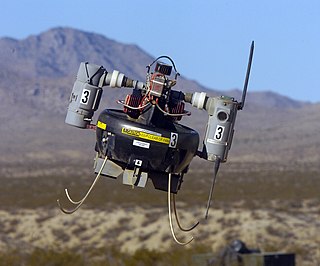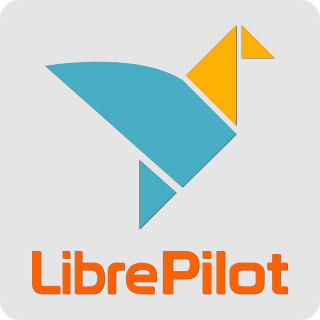Related Research Articles

An unmanned aerial vehicle (UAV), commonly known as a drone, is an aircraft without any human pilot, crew, or passengers on board. UAVs were originally developed through the twentieth century for military missions too "dull, dirty or dangerous" for humans, and by the twenty-first, they had become essential assets to most militaries. As control technologies improved and costs fell, their use expanded to many non-military applications. These include aerial photography, precision agriculture, forest fire monitoring, river monitoring, environmental monitoring, policing and surveillance, infrastructure inspections, smuggling, product deliveries, entertainment, and drone racing.

An aircraft pilot or aviator is a person who controls the flight of an aircraft by operating its directional flight controls. Some other aircrew members, such as navigators or flight engineers, are also considered aviators because they are involved in operating the aircraft's navigation and engine systems. Other aircrew members, such as drone operators, flight attendants, mechanics and ground crew, are not classified as aviators.

An autopilot is a system used to control the path of an aircraft, marine craft or spacecraft without requiring constant manual control by a human operator. Autopilots do not replace human operators. Instead, the autopilot assists the operator's control of the vehicle, allowing the operator to focus on broader aspects of operations.

A micro air vehicle (MAV), or micro aerial vehicle, is a class of man-portable miniature UAVs whose size enables them to be used in low altitude, close-in support operations. Modern MAVs can be as small as 5 centimeters. Development is driven by commercial, research, government, and military purposes; with insect-sized aircraft reportedly expected in the future. The small craft allows remote observation of hazardous environments inaccessible to ground vehicles. MAVs have been built for hobby purposes such as aerial robotics contests and aerial photography.

A remote-control vehicle also known as teleoperated vehicle, is defined as any vehicle that is teleoperated by a means that does not restrict its motion with an origin external to the device. This is often a radio-control device, a cable between the controller and the vehicle, or an infrared controller.

Teleoperation indicates operation of a system or machine at a distance. It is similar in meaning to the phrase "remote control" but is usually encountered in research, academia and technology. It is most commonly associated with robotics and mobile robots but can be applied to a whole range of circumstances in which a device or machine is operated by a person from a distance.

UAVs include both autonomous drones and remotely piloted vehicles (RPVs). A UAV is capable of controlled, sustained level flight and is powered by a jet, reciprocating, or electric engine. In the twenty first century technology reached a point of sophistication that the UAV is now being given a greatly expanded role in many areas of aviation.
The usefulness of UAVs for aerial reconnaissance was demonstrated to the United States in the Vietnam War. At the same time, early steps were being taken to use them in active combat at sea and on land, but unmanned combat aerial vehicles would not come into their own until the 1980s.

A miniature UAV, small UAV (SUAV), or drone is an unmanned aerial vehicle small enough to be man-portable. Smallest UAVs are called micro air vehicle.

The Prioria Robotics Maveric is a discontinued unmanned aerial vehicle (UAV) marketed as a high-performance, next-generation platform for small and miniature UAV operations. Maveric's bendable wings allow for the ability to store a fully assembled airframe in a 6-inch (150 mm) tube.

An uncrewed vehicle or unmanned vehicle is a vehicle without a person on board. Uncrewed vehicles can either be under telerobotic control—remote controlled or remote guided vehicles—or they can be autonomously controlled—autonomous vehicles—which are capable of sensing their environment and navigating on their own.

LibrePilot is a Free software unmanned aerial vehicle project for model aircraft aimed at supporting both multi-rotor craft as well as fixed-wing aircraft. Initially founded by David Ankers, Angus Peart and Vassilis Varveropoulos in late 2009, under the name OpenPilot, it was conceived as both a learning tool and to address areas the developers perceived were lacking in other small UAV platforms. In July 2015 OpenPilot, was forked to create LibrePilot.
An optionally piloted vehicle (OPV) or optionally piloted aerial vehicle is a hybrid between a conventional piloted aircraft and an unmanned aerial vehicle (UAV).
Paparazzi is an open-source autopilot system oriented toward inexpensive autonomous aircraft. Low cost and availability enable hobbyist use in small remotely piloted aircraft. The project began in 2003, and is being further developed and used at École nationale de l'aviation civile (ENAC), a French civil aeronautics academy. Several vendors are currently producing Paparazzi autopilots and accessories.
ArduPilot:Copter previously named APM:Copter or ArduCopter is the multicopter unmanned aerial vehicle version of the open-source ArduPilot autopilot platform.
ArduPilot is an open source, unmanned vehicle Autopilot Software Suite, capable of controlling autonomous:
The PX4 autopilot is an open-source system designed for affordable autonomous aircraft. Its cost-effectiveness and widespread availability make it suitable for hobbyists operating small and remotely piloted aircraft. Originating in 2009, this project is continually evolving, with ongoing development and utilization at the Computer Vision and Geometry Lab of ETH Zurich. It also receives support from the Autonomous Systems Lab and the Automatic Control Laboratory. Currently, numerous vendors are manufacturing PX4 autopilots and associated accessories.
The Information Age is generally understood to have arrived with the Internet as it was developed through the 1970s and rolled out throughout the 1980s, and continues evolving to this day. So too the adoption of digital techniques in aviation also arrived progressively at around the same time and also continues today.
Unmanned aircraft system simulation focuses on training pilots to control an unmanned aircraft or its payload from a control station. Flight simulation involves a device that artificially re-creates aircraft flight and the environment in which it flies for pilot training, design, or other purposes. It includes replicating the equations that govern how aircraft fly, how they react to applications of flight controls, the effects of other aircraft systems, and how the aircraft reacts to external factors such as air density, turbulence, wind shear, cloud, precipitation, etc.
An autonomous aircraft is an aircraft which flies under the control of automatic systems and needs no intervention from a human pilot. Most autonomous aircraft are unmanned aerial vehicle or drones. However, autonomous control systems are reaching a point where several air taxis and associated regulatory regimes are being developed.